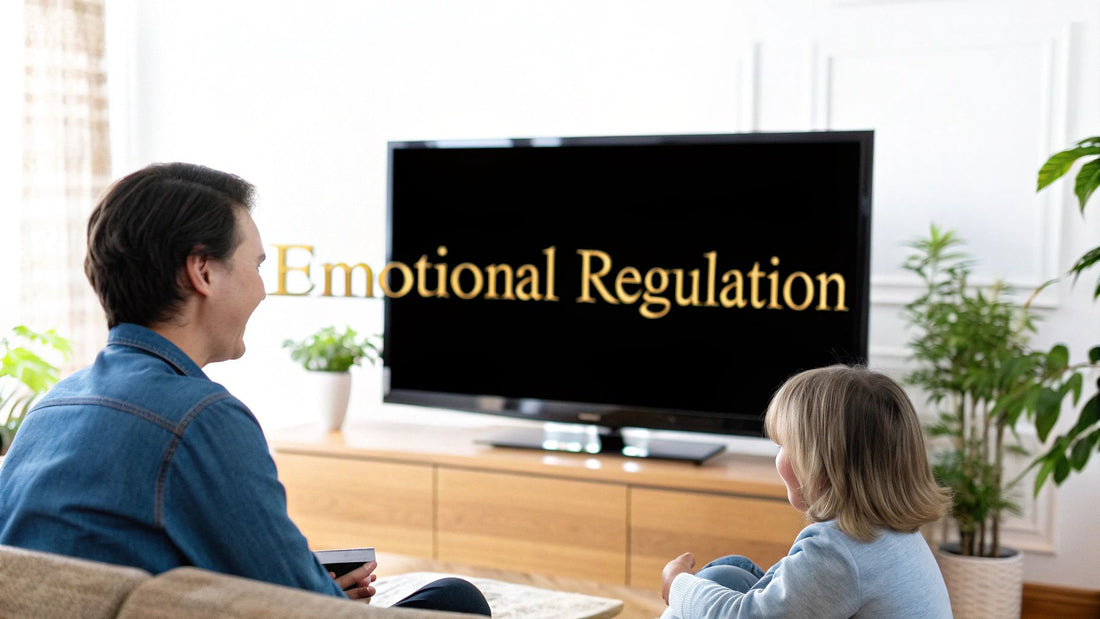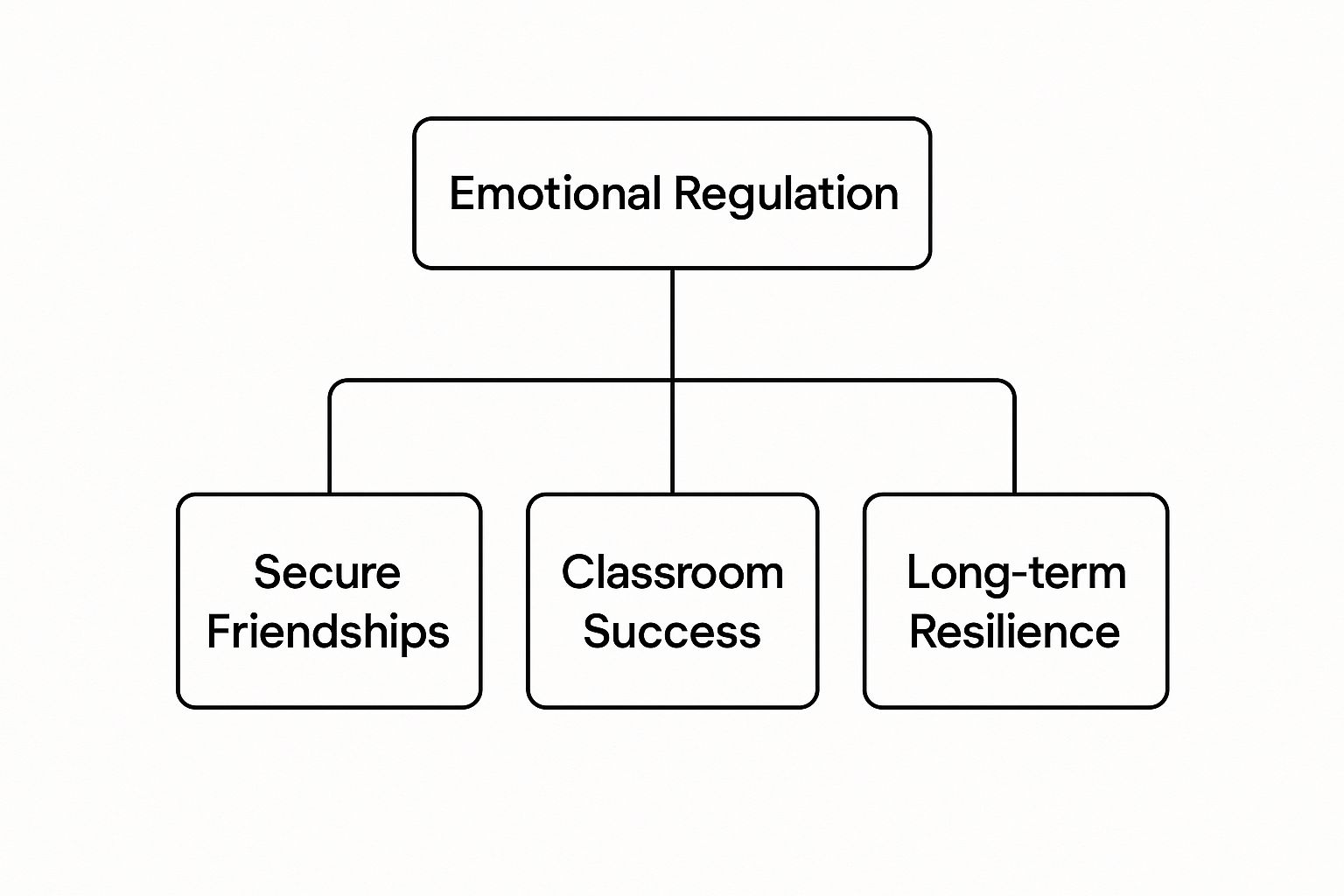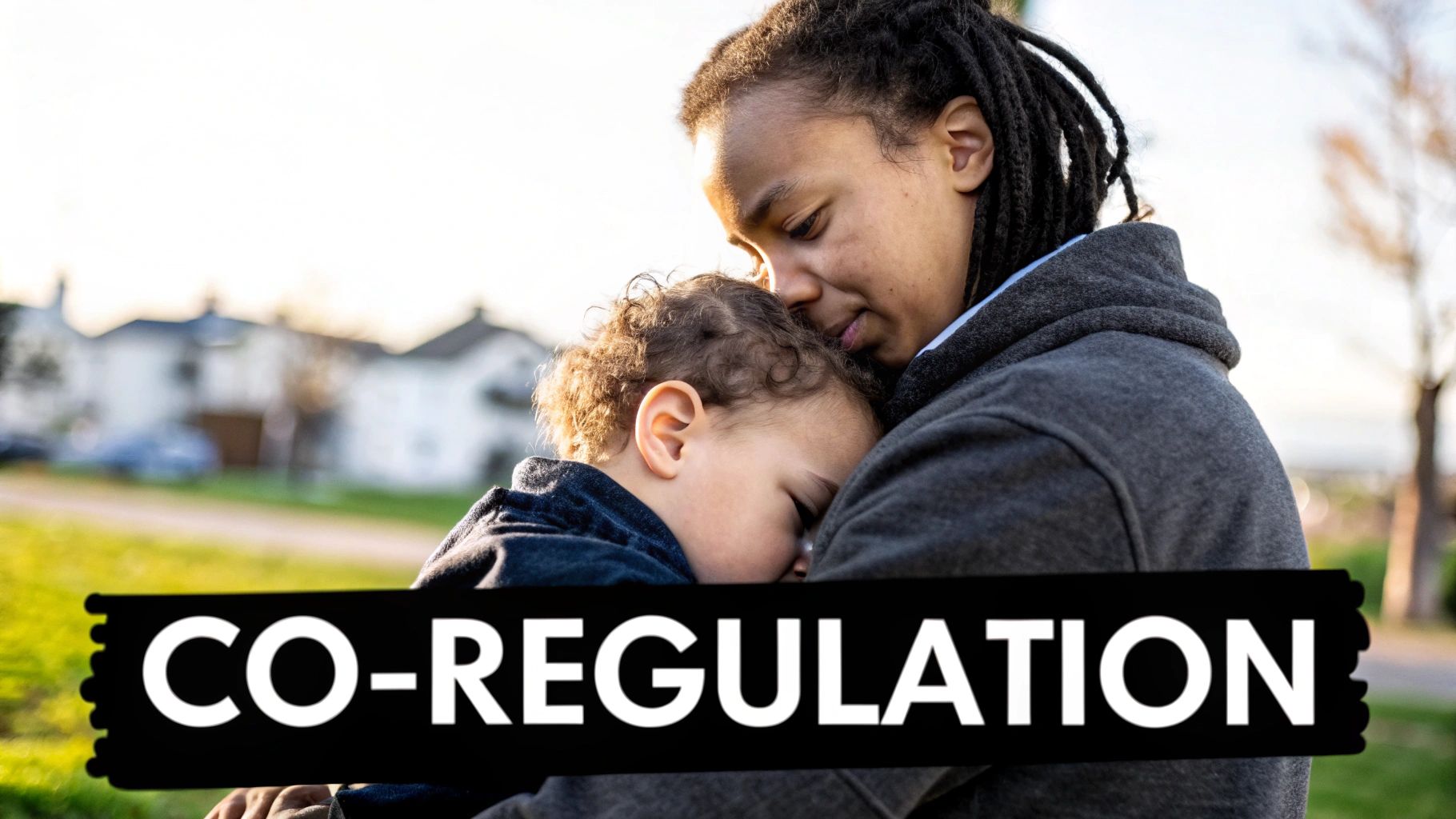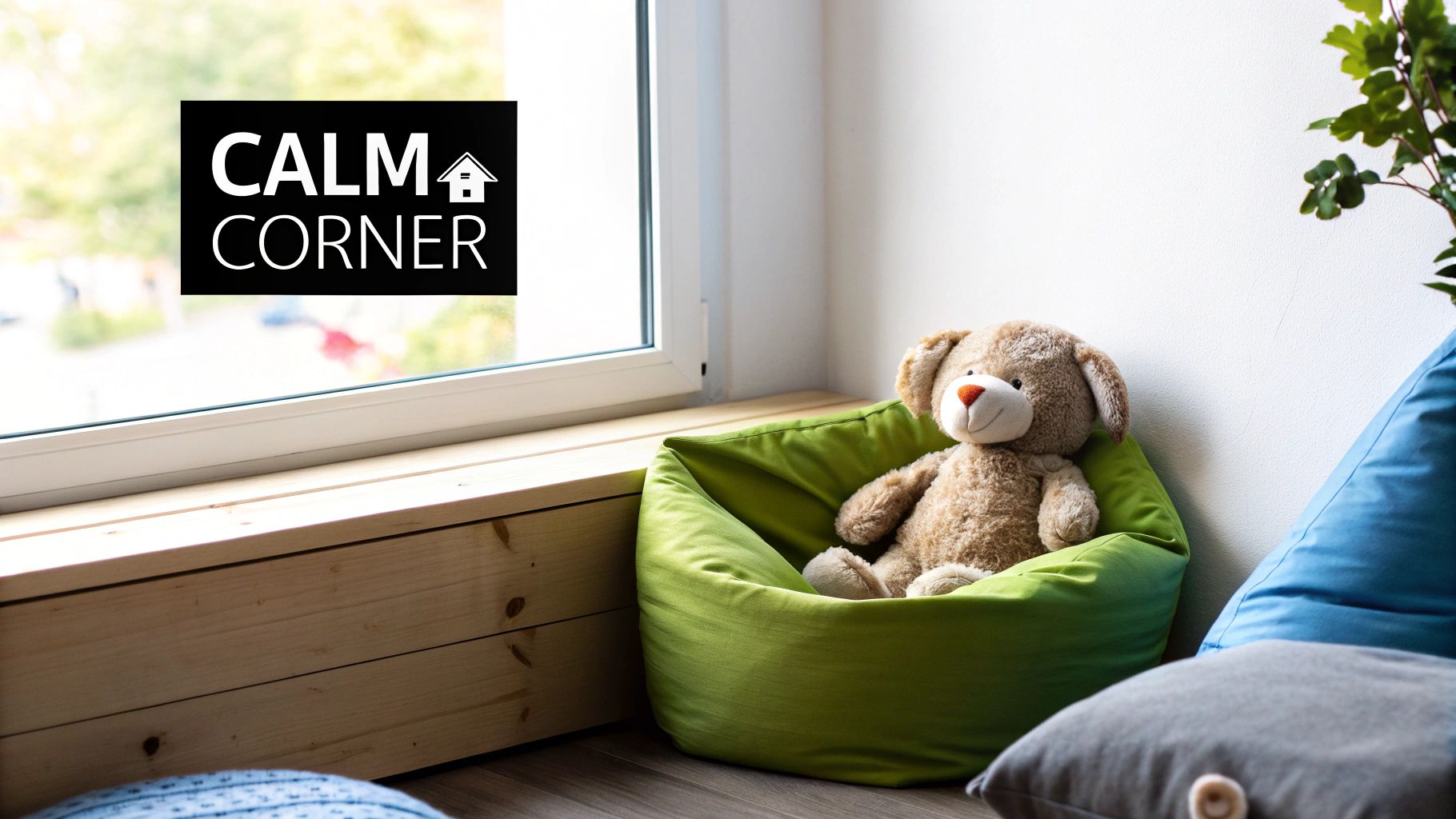
What Is Emotional Regulation in Children?
Share
Emotional regulation is simply the ability to understand and manage your emotional responses. It’s not about stuffing feelings down or pretending they don’t exist, but about navigating them constructively. It's what helps our children respond to tricky situations in a healthy and socially acceptable way.
Understanding Emotional Regulation

Imagine your child's emotions are like a powerful river. A huge feeling like anger or sadness can feel like a raging current, threatening to pull them under. Learning what is emotional regulation isn’t about building a dam to stop the river; it’s about giving them a paddle and teaching them how to steer.
This is a vital skill that develops over time, not some indicator of 'good' or 'bad' behaviour.
When we break it down, emotional regulation involves several key abilities that all work together. It’s a process that allows a child to move from being totally overwhelmed by a feeling to managing it effectively.
The Core Components of This Skill
At its heart, this skill can be understood through four distinct but connected steps. Getting to grips with these helps children build real resilience and confidence.
- Noticing a Feeling: This is the first step—simply recognising that an emotion is present. It’s the internal alarm bell that says, "I'm feeling something big right now."
- Understanding Its Source: Next is connecting the emotion to its trigger. For example, a child might realise, "I feel frustrated because my tower of blocks fell over." This step is closely linked to developing good emotional literacy.
- Choosing a Response: Instead of reacting impulsively (like screaming or hitting), the child learns to pause. In that pause, they can decide on a more helpful action, like taking three deep breaths, asking for a hug, or stomping their feet on the spot.
- Managing the Body’s Reaction: This is all about calming the physical side of strong emotions—the racing heart or tense muscles—through conscious effort.
Important Note: This content is for informational purposes only and is not a substitute for professional medical advice. I am not a mental health professional. If you have serious concerns about your child's mental health or wellbeing, please consult your GP or a qualified practitioner.
Helping our children develop these abilities is one of the most important investments we can make in their long-term mental health. It truly sets the foundation for success in school, friendships, and life.
Why This Skill Matters More Than Ever
Let's be honest, in today's world, learning to manage big feelings is less of a 'soft skill' and more of a superpower. It's a fundamental building block for a child's future, touching everything from how they get on with friends at school to their mental wellbeing years down the line. It's crucial to address mental health openly and early, creating a foundation of emotional resilience that will support them throughout their lives.
When a child hasn't quite got the hang of emotional regulation, you see the fallout. It might look like a struggle to focus in class, pulling away from friends, or those huge, overwhelming outbursts that leave everyone feeling drained. These aren't signs of a 'naughty' child; they're often distress signals from a little nervous system that's completely overwhelmed. The latest NHS data reveals that 1 in 5 children and young people in England now have a probable mental health condition. Addressing these challenges early is vital.
Think of it like this: strong emotional regulation is the foundation that everything else is built on.

As you can see, handling feelings well isn't some isolated skill. It’s the very core that supports a child's entire world, from the playground to the classroom.
A Buffer Against Modern Pressures
This isn't just theory; it's become incredibly urgent. Children today are navigating a world full of unique challenges, from the non-stop comparison culture of social media to ever-increasing pressure to do well at school. Building their emotional skills early on gives them a vital protective buffer against all this stress.
A growing wave of research right here in the UK backs this up. One powerful study found that children who struggled to regulate their emotions at age seven were far more likely to face anxiety and depression as teenagers. You can dive deeper into the University of Edinburgh's findings on child emotional development if you're interested. This kind of evidence completely reframes how we should see these skills – not just as a part of parenting, but as essential, preventative mental healthcare.
The ability to manage emotions effectively is a stronger predictor of success in school and life than IQ. By nurturing this skill, we give children the tools to not just survive challenges but to thrive despite them.
The Wider Impact on Society
The knock-on effect of neglecting emotional wellbeing is massive, stretching well beyond our own homes. Poor mental health puts an incredible strain on our society and economy. In fact, Deloitte estimates that poor mental health costs UK businesses up to £56 billion every single year through absenteeism, presenteeism, and staff turnover.
When we invest in a child’s emotional toolkit from the very beginning, we’re really investing in a healthier, more resilient future generation. It’s all about giving them the internal resources they need to walk through a complicated world with confidence and calm. And in doing that, we're not just helping our own kids – we're building a more emotionally intelligent and supportive community for everyone.
How Children Learn to Manage Emotions
A child’s ability to handle big feelings isn't something that just clicks into place one day; it’s a skill that develops slowly over time, much like learning to walk or talk. This isn't about willpower—it's a biological process, driven by the way their amazing brain grows and forms new connections. When we understand this, it completely reframes how we see their behaviour and how we respond to it.

A great way to picture this is to think of a child's brain in two parts. You've got the 'downstairs' emotional brain, which is the home of big, raw feelings like fear and anger. Then you have the 'upstairs' thinking brain, which manages logic, problem-solving, and control. In young children, the downstairs brain is fully operational and very loud, but the staircase connecting it to the upstairs brain is still under construction.
So, when a toddler is having a full-blown tantrum, they aren't choosing to be defiant. Their emotional brain has staged a complete takeover, and they literally can't access the logical, calming part of their brain to pull themselves together.
The Power of Co-Regulation
This is exactly where we come in. As parents and carers, our most powerful tool is something called co-regulation. When we manage to stay calm during our child’s emotional storm, our regulated nervous system acts like an external anchor for theirs. We are, in effect, lending them our calm until their own 'upstairs brain' can get back online. For example, when a child is crying loudly, instead of telling them to 'stop crying', a parent can sit with them, use a soft voice and say, "That was a really big fall. It's okay to be upset. I'm right here with you."
This isn't just a short-term fix; it’s how we help build the neural pathways they’ll need for self-regulation later on. It’s a massive part of what we call social emotional learning and, through experience, it teaches children that big feelings are intense but survivable. Laying this foundation is absolutely critical for their long-term mental health.
Co-regulation isn't about fixing a problem or stopping tears. It's about being a safe harbour in an emotional storm, showing your child, "You are safe, this feeling will pass, and I am right here with you."
The skills learned in these early years have a real, lasting impact. UK-based research has shown a clear link between a child's ability to manage their emotions between the ages of 3 and 7 and their psychiatric health in their teenage years. Poor emotional regulation in early childhood was found to be a predictor for symptoms of certain eating disorders in adolescence. You can learn more about these findings on childhood emotional development.
Developmental Milestones at a Glance
Knowing what's typical for each age and stage helps us offer the right kind of support at the right time. A child's ability to manage their feelings evolves so much as they grow, and our approach needs to evolve with them.
Here’s a quick guide to what you might expect along the way.
Developmental Milestones in Emotional Regulation
This table provides a snapshot of typical emotional regulation skills at different ages, helping you understand what to expect and how you can help.
| Age Group | What to Expect | How Parents Can Help (Co-regulation) |
|---|---|---|
| 0-2 Years | Totally reliant on carers. Expresses all needs through crying and can get overstimulated very easily. | Respond quickly to their needs. Use a calm voice, gentle touch, and swaddling or rocking to soothe them. |
| 2-3 Years | The classic "tantrum" stage. Expect big emotional swings, very little impulse control, and a real struggle to share. | Acknowledge the feeling ("You are so cross right now!"). Stay physically close and offer hugs or comfort. |
| 4-5 Years | Begins to use words to express feelings. Starts to understand that other people have emotions, too. Still needs lots of support. | Help them put a name to their feelings ("It sounds like you feel frustrated"). Model taking deep breaths and create a 'calm-down' space. |
| 6-11 Years | Getting better at using strategies to calm down. More aware of social rules and the consequences of their actions. | Talk through problems together. Help them brainstorm solutions and remember to praise their efforts to self-regulate. |
Remember, this is a journey, not a race. Every child develops at their own pace, and consistent, loving support is what matters most.
To keep things light and engaging, you could also try incorporating some fun emotional regulation activities for kids into your routine. These games and exercises are a brilliant way to make learning these vital skills feel like play.
Navigating Modern Challenges to Emotional Health
Today’s world throws a unique set of curveballs at children who are just learning to manage their emotions. The pressures are different now, and they often come from places that are almost impossible to switch off. Understanding these hurdles is the first step in helping our kids build the resilience they’ll need for life.
One of the biggest modern pressures is, without a doubt, social media. The endless scroll through perfectly curated lives can kickstart a relentless cycle of comparison and anxiety. It’s incredibly difficult for a young person to feel good about who they are when they’re constantly being shown a filtered, unrealistic version of everyone else. The constant need for validation through likes and shares can make normal emotional ups and downs feel like public failures, amplifying feelings of sadness and frustration.
This kind of environment can easily throw a child's emotional development off course. When their self-worth gets tangled up in likes and comments, the normal ups and downs of life can feel like huge personal failures, making feelings of sadness and frustration feel so much bigger.
The Impact of External Pressures
It's not just what’s happening on a screen. Academic expectations can also feel totally overwhelming. The pressure to succeed and follow a very specific path can leave little room for children to just be—to explore, make mistakes, and learn from them.
All these external factors create a pretty challenging backdrop for learning what emotional regulation is. This is exactly why a stable, supportive home life is more critical than ever. Home needs to be a safe harbour where kids can process all those outside pressures without fear of judgement.
The family is a child’s first emotional classroom. The lessons they learn at home about handling stress, showing empathy, and talking about their feelings are what build a lifelong foundation for mental wellbeing.
The emotional health of children in the UK is deeply intertwined with their family environment, especially when parents are struggling themselves. Official statistics show a direct link between a parent's emotional distress, like anxiety or depression, and how their child is faring. A parent's struggle can get in the way of their child’s own ability to learn emotional regulation, making them more vulnerable down the line. You can explore the government's findings on children's emotional health for more details.
Wider Societal Effects
This isn’t just a private family matter; the ripple effects are huge. As mentioned, poor mental health in the workforce costs UK businesses tens of billions every single year. Investing in our children's emotional health from a young age is a real investment in a healthier, more resilient future for everyone.
As we support our kids, it's just as important to model how to look after ourselves. Here are a few simple relaxation tips to get you started:
- Mindful Breathing: Just take five deep, slow breaths. Really focus on the feeling of the air coming in and going out. It's a simple, powerful tool you can use anywhere.
- A Quick Walk: Even ten minutes of walking outside can do wonders for clearing your head and dialling down stress. The change of scenery and fresh air can shift your perspective.
- Listen to Music: Pop on a favourite calming song and give yourself a peaceful moment in a busy day. Create a 'calm' playlist you can turn to when you feel overwhelmed.
By truly understanding the world our children are growing up in, we can offer more informed and empathetic support. We can validate their feelings and guide them with real compassion.
Practical Ways to Build Emotional Skills

Knowing the theory is one thing, but actually putting it into practice at home is where the real magic happens. This is your go-to toolkit for nurturing emotional intelligence, framing these strategies as supportive coaching rather than old-school discipline. When we proactively teach these skills, we give our children the tools they need to navigate their own inner world.
The great news is that you don’t need to be a mental health expert to make a huge difference. Small, consistent actions can build a powerful foundation for emotional wellbeing.
A Gentle Reminder: The strategies below are for guidance and support. As I am not a mental health professional, it's vital to seek help from your doctor or a qualified therapist if you are worried about your child's mental health. Asking for help is a sign of strength.
Name It to Tame It
One of the most powerful things we can do is help children build their emotional vocabulary. It’s a simple but profound idea: when a child can put a name to a big, scary feeling, it instantly becomes less overwhelming.
So, instead of saying, “Stop being naughty,” try something like, “It looks like you're feeling really frustrated that your game isn't working.” This simple switch validates their experience and teaches them the word for what they’re feeling. Over time, this builds the self-awareness they need to understand their own emotional triggers. You can also explore our guide on other powerful coping strategies for children to expand your toolkit.
Create a Calm-Down Corner
Every home can benefit from a designated safe space where a child can go when they feel overwhelmed. This isn’t a punishment or a ‘naughty step’; it's a cosy retreat they choose to use when their feelings get too big to handle.
Fill it with items that help soothe their nervous system:
- Soft things: Cushions, a weighted blanket, or a favourite stuffed toy.
- Fidget toys: Squeeze balls or other sensory items can help release pent-up tension.
- Calming visuals: A glitter jar or books with gentle, soothing pictures.
- Books on emotions: A curated selection of books can help them make sense of what they're feeling.
This corner gives them a physical place to practise self-regulation, sending the clear message that it’s perfectly okay to take a break when you need one.
Teach Simple Grounding Techniques
When emotions run high, the body can tip into fight-or-flight mode. Grounding techniques are simple, brilliant little tricks that bring a child back to the present moment and calm their physical response.
Box Breathing:
- Breathe in slowly for a count of four.
- Hold your breath for a count of four.
- Breathe out slowly for a count of four.
- Wait for a count of four before breathing in again.
The 5-4-3-2-1 Method:
Ask your child to quietly name:
- 5 things they can see.
- 4 things they can feel.
- 3 things they can hear.
- 2 things they can smell.
- 1 thing they can taste.
These practical tools empower children with a sense of control over their emotional responses, showing them they have the power to steer their own ship, even in stormy seas.
Helpful Resources for Your Family
Helping your child navigate their emotional world is a long-haul journey, not a sprint. To give you a hand along the way, we’ve put together a few trusted resources that can make a real, tangible difference for your family.
A brilliant way to get those conversations started is by snuggling up with a good book. You can find a fantastic selection of essential kids books on emotions that help little ones make sense of their big feelings in a way that just clicks. Stories are a gentle, effective way to plant those important seeds. For example, 'The Colour Monster' by Anna Llenas is a wonderful book that helps young children identify and separate their feelings.
Normalising the Conversation
Another way to keep these positive messages alive is through the simple things you use every day. Think about mental health apparel – a t-shirt or a hoodie with a supportive message like "It's Okay To Not Be Okay" can subtly normalise discussions around wellbeing. It turns talking about feelings into a regular, no-big-deal part of family life and acts as a small, visual reminder that mental health is just as important as physical health.
A final, crucial reminder: I am not a mental health professional. If you ever find yourself seriously worried about your child’s emotional wellbeing, please know that reaching out to your GP or a qualified child therapist is a sign of strength, not weakness. It's proactive care, and they can offer the expert guidance your family deserves.
Have a Question?
It's completely normal to have more questions as you navigate this journey with your child. Here are some of the most common ones that pop up for parents, with some straightforward answers to give you a bit more clarity.
What’s the Difference Between a Tantrum and a Meltdown?
This is a big one, and knowing the difference is key to how you respond. Think of a tantrum as a child’s (often clumsy) attempt to get something they want. They might throw a fit over a toy, but they’re still somewhat in control – you might even catch them peeking to see if you’re watching their performance!
A meltdown, on the other hand, is a complete and total loss of control. It’s not a choice. It’s an involuntary reaction to being utterly overwhelmed, where their 'thinking brain' has gone completely offline. Understanding this helps you meet a meltdown with compassion and support, rather than discipline.
When Should I Genuinely Worry About My Child’s Emotional Regulation?
First off, remember that all children struggle with big feelings sometimes. Bumpy moments are part of the deal. The time to think about seeking extra support is when you notice a persistent pattern that’s really starting to impact their daily life.
If your school-aged child is consistently having extreme reactions, can’t be soothed, or if their emotional outbursts are starting to harm their friendships, their experience at school, or the peace in your family, it’s a good idea to chat with your GP, the school’s support staff, or a child mental health professional.
A Quick but Important Note: I'm not a mental health professional, and this advice is here to inform, not to diagnose. If you have serious concerns about your child's wellbeing, please, always consult your doctor or another qualified practitioner.
How Can I Help My Teenager Who Just Refuses to Talk?
Ah, the teenage years. When they clam up, pushing for a big heart-to-heart rarely works. Instead, your actions become your most powerful language. The best thing you can do is model healthy emotional regulation yourself—talk openly about how you handle your own stress or a tough day.
Look for low-pressure moments to connect, like when you’re driving somewhere or just walking the dog. It’s often in these side-by-side moments, without intense eye contact, that they feel safer to open up. Your consistent, calm, and non-judgemental presence is what builds the foundation of trust.
You can also gently leave resources around without making a big deal of it – maybe a book on a shelf or a mindfulness app you’ve found. It’s a quiet way of showing you're a safe harbour they can come back to when they feel ready.
At Little Fish Books, we create beautiful books, activities, and apparel to help children and families talk openly about mental health and wellbeing. Explore our supportive resources today at https://thatsokay.co.uk.
